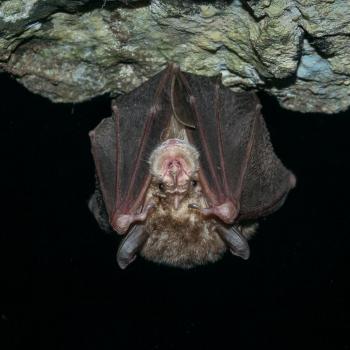Blasius's horseshoe bat
-
Rhinolophus blasii, (Peters, 1866)
It is a medium-sized bat with a wingspan of up to 28 cm and weight of 10 to 14 grams. The fur on its back is pale brown or yellowish with a whitish base, while on the abdomen it is slightly pale. Both saddle protrusions are sharp, and only in some individuals of this species the skin fold under the blade has a groove in the middle. At the fourth finger the first phalanx is more than half the length of the second, unlike Rhinolophus euryale and R. mehelyi where the first phalanx is less than half the length of the second.
It has a broad but fragmented distribution in the eastern sub-Saharan and northwestern Africa, the Balkans and the eastern Mediterranean (including many islands), the southern and eastern Arabian Peninsula, Iran, Afghanistan and Pakistan. Recently disappeared from Italy and Slovenia. The taxonomic position of its Asian and African populations needs investigation. It is quite common in Greece, as it is found throughout the mainland, and has also been found in many Aegean and Ionian Islands and Crete.
Blasius's horseshoe bat prefers low- and moderate-altitude karst areas with low vegetation and sparse trees. Its colonies (usually dense clusters of a few hundred individuals) are usually formed in limestone caves and mines. It often shares its shelter with other species of the genus Rhinolophus, Myotis and Miniopterus. It spends the winter in caves with mild temperatures (13.8 - 17 degrees Celsius).
It has a very flexible flight and usually flies near the vegetation. It hunts in a radius of a few kilometers around its shelter. In Crete it is active even in winter when the weather allows. Its diet is known only from Rodopi, where it feeds almost exclusively on moths.
Little is known about the reproductive habits of this species, but mating takes place in the fall (if not later) inside roosts. Females mature sexually after the second year of age and give birth to only one young. In Crete, juveniles are weaned already in early June, probably when the climate of the previous spring is favorable.
It is included in Annex II of the Bern Convention and the Bonn Convention. It is also included in Annexes II and IV of EU Directive 92/43. It is also protected by UNEP/EUROBATS and in Greece, by the Presidential Decree 67/81. Because of its wide distribution it is considered as a species of Least Concern (LC) worldwide (IUCN), but in the Greek Red Book of Endangered Animals it is classified as Near Threatened (NT), as so far no large colonies have been found in our country. The causes of its disappearance from the southeastern Alps and the dramatic shrink of its populations in Romania and Bulgaria are unknown. It is threatened mainly by the degradation of its roosts (tourist exploitation of caves, the collapse of abandoned mines, roost closures, etc.).



